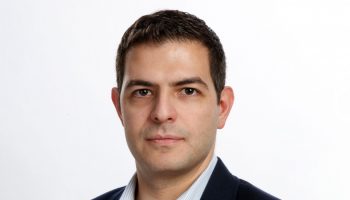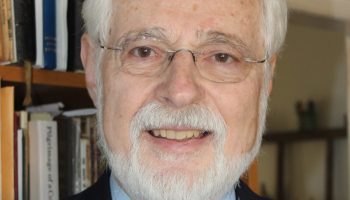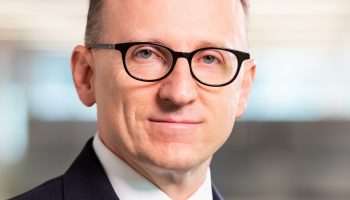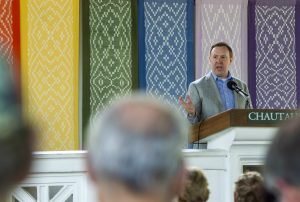
On Tuesday, the Rt. Rev. V. Gene Robinson, vice president of religion and senior pastor, said many crazy and wonderful things have come out of the Burned-over District.
“You only get to call your own religion crazy,” said Patrick Mason, an author, historian and Leonard J. Arrington Endowed Chair of Mormon History and Culture at Utah State University. “So, I’m happy to talk about Mormonism — this particularly crazy and wonderful thing that came out of the Burned-over District.”
Mason continued Week Five’s interfaith theme, “Chautauqua: Rising from the Ashes of the Burned-Over District,” in the Hall of Philosophy with his lecture, “Mormonism: From the Burned-Over District to a New World Religion.”
Mason said Mormonism began in 1820, with a 14-year-old boy named Joseph Smith, who was so confused by the religious fervor exploding across Western New York where he and his family lived, that he couldn’t decide which religion had the “correct” view.
“The religious fervor of the Burned-over District left Joseph Smith deeply concerned about the state of his soul and the spiritual state of the world,” Mason said. “Rather than being exhilarated by the intensity of the revivals around him, he found himself exhausted and confused by the spiritual cacophony.”
“If anybody lacks wisdom, they should ask God” – Mason reads a quote from a scripture. #CHQ2019
— The Chautauquan Daily (@chqdaily) July 23, 2019
Advised by a Methodist preacher who told Smith to pray to God and ask for help in choosing a correct religion, Smith went into the forest near his family’s house to pray in private. While praying, Smith felt a sudden, evil presence overwhelm him, and then he felt himself become liberated from it by a “heavenly visitation,” Mason said.
Mason quoted Smith’s writing: “I saw a pillar of light exactly over my head above the brightness of the sun, which descended gradually until it fell upon me and no sooner. … I found myself delivered from the enemy, which held me bound. When the light rested upon me, I saw two personages whose brightness and glory defy all descriptions, standing above me in the air. One of them spoke to me, calling me by name, and said, pointing to the other, ‘This is my beloved son. Hear him.’ ”
Smith said he asked the two personages which church he should join, and he said that the personage that looked like Jesus said none of the churches were correct. So, Smith returned home, did not join any of the churches, and wouldn’t receive another vision for three more years, Mason said.
When Smith finally did receive another vision, it was September 1823. Smith was 17 years old, and the vision was a result of him praying for forgiveness for his sins.
“While he was praying, Smith said that he discovered a light appearing in his room, which continued to increase until the room was lighter than at noon day,” Mason said. “Then, immediately a personage appeared at (his) bedside. In the air before him hovered a man clothed only in a white robe, his entire being seeming to glow.”
This angel, Mason said, called himself Moroni and informed Smith of gold plates under a stone on a hill near Smith’s home. Moroni described the plates as containing the “fullness of the Everlasting Gospel book as delivered by the Savior Jesus Christ to its ancient inhabitants,” Mason said.
Although it would take Smith four years to retrieve the plates and another two-and-a-half years for him to translate the plates’ engravings into English, all of this work resulted in the 588-page tome, The Book of Mormon.
When The Book of Mormon went to press, Smith had gained a small number of followers who believed him to be a prophet. In April 1830, these followers came together to formally organize a church, which they called the Church of Christ.
“Most converts … were drawn to the more visceral aspect of early Mormonism: the outpouring of spiritual gifts that were visions and dreams and healings and speaking in tongues,” Mason said. “They rejoiced in a new era of open revelation. The heavens were opened once again; God was sending his spirit to the Earth; he had called a new prophet; there were angels coming to the Earth. This was all rather miraculous in these early converts’ eyes.”
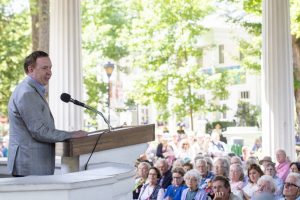
Smith and his followers believed this religion to be an answer to the religious competition in the Burned-over District, but what they found was that the other religions were intolerant of Mormonism. Smith himself experienced hostility and was told his visions were not from God, but from the devil.
And so, Smith and his followers moved from New York, going first to Ohio and eventually settling in Utah. In 1838, Smith changed the name of the church from the Church of Christ to the Church of Jesus Christ of Latter Day Saints.
Despite the intolerance and migration, Mason said, the Mormons could not be kept from sharing their religion with others. Soon after the church was established in New York, for example, Smith’s brother and father traveled to Canada to tell friends about The Book of Mormon. At the same time, missionaries also traveled beyond the western frontier to preach the Gospel to Native Americans.
“Mormonism transcended national boundaries almost immediately,” Mason said. “During Joseph Smith’s lifetime, missionaries traveled to places as far-flung as the British Isles, Australia, Prussia, Germany and Palestine.”
After Smith’s brutal murder in 1844, Brigham Young led the church and served missions in Canada and England. He also expanded the church, sending missionaries to places like Hawaii, Jamaica, Chile, South Africa and India.
Mormons were most successful in converting people in England and Scandinavia. Once converted, many migrated to the United States to join the church.
“It took the LDS church 117 years from its founding in 1830, to reach the 1 million member mark in 1947,” Mason said. “It gained another million members in only 16 years … and since then, the church has added about a million members worldwide, every three to four years. So now, it stands at over 16 million members.”
Mason speaks on discrimination within Mormonism involving African-Americans, women, and the LGBTQ community. #Chq2019
— The Chautauquan Daily (@chqdaily) July 23, 2019
Mason attributes this intense growth to missionary work. When 65,000 Mormon missionaries are sent out into the world, Mason said, the chances are great that the religion is going to grow.
This religious growth is so profound that, in the 1980s, non-Mormon sociologist Rodney Stark declared that Mormonism stands on the threshold of becoming a major faith, Mason said.
The question is, though: Is Mormonism the world’s next major faith? Is Mormonism a new world religion?
Mason said most of the growth within the religion is international. Over 70% of Mormon churches that are not in the United States are in Latin America, and about 85% of all current Mormons live in North, Central or South America.
Mason said Mormonism is a religion of the new world: the Western Hemisphere. However, Mason said Mormonism must face a number of obstacles before becoming a new world religion.
“So first, there’s a problem with public image,” Mason said. “In 2011, the Pew Forum (on Religion and Public Life) took a national poll where it asked respondents to give a one-word association with Mormonism … and three of the top four answers were ‘polygamy,’ ‘cult’ and ‘different.’ ”

Mason himself has dealt with stereotypes. He said he once offered a fellow graduate student a ride to the grocery store, and the student was surprised because he knew Mason was a Mormon, so he expected Mason to have a horse and buggy. Above all, Mason finds one stereotype to be the most misunderstood: polygamy.
“It remains the number one thing that people, both in this country and around the world, continue to associate with the church,” Mason said. “The mainstream LDS church has not endorsed the practice for more than a century.”
Mason said the church also has a history of racism, having denied black men from ordination in the priesthood and all black men and women access to the church’s sacred temples until 1978.
The church has evolved from its past, but Mason believes Mormonism has a long way to go before it can be seen in a more positive light.
For example, although Mormons have become more open to the LGBTQ community, same-sex marriage remains theologically and practically off the table, Mason said. In trying to keep the integrity and unity of the institution, Mason said, the church also makes little effort to accommodate foreign cultures.
“When Mormonism comes to a country, it comes with a ready-made set of doctrines and programs and hymns and all kinds of stuff translated into the local language,” Mason said, “but not with any real accommodations for local culture.”
So the question remains, does Mormonism belong in the list of world religions, or does it belong in the Christian family tree?
“There were moments in the religion’s past, especially in the late 19th century … when the religion might have … charted this course as a totally new religious tradition,” Mason said. “But I think, in the 20th century, church members and leaders opted for a strategy of accommodation, of respectability, and desperately want to be known as Christians.”
Mason said the main challenge Mormons face is when they go to preach the Gospel, they are asking the same questions Smith and his followers were asking in the 1830s.
“The world is changing,” Mason said. “Mormonism will have to adapt … if it wants to remain relevant and impactful. It’s been proven that you can take Mormonism out of the Burned-over District. The question is, can you take the Burned-over District out of Mormonism?”


